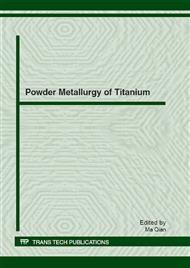[1]
F.H. Froes, D. Eylon, Powder metallurgy of titanium alloys, Int. Mater. Rev. 35 (1990) 162-190.
Google Scholar
[2]
J.E. Barnes, W. Peter, C.A. Blue, Evaluation of low cost titanium alloy products, Mater. Sci. Forum 618-619 (2009) 165-171.
DOI: 10.4028/www.scientific.net/msf.618-619.165
Google Scholar
[3]
T. Saito, H. Takamiya, T. Furuta, Thermomechanical properties of P/M b titanium metal matrix composite, Mater. Sci. Eng. A 243 (1998) 273-278.
DOI: 10.1016/s0921-5093(97)00813-7
Google Scholar
[4]
O.M. Ivasishin, D. Eylon, V.I. Bondarchuk, D.G. Savvakin, Diffusion during powder metallurgy synthesis of titanium alloys, Defect Diff. Forum, 277 (2008) 177–185.
DOI: 10.4028/www.scientific.net/ddf.277.177
Google Scholar
[5]
O.M. Ivasishin, D.G. Savvakin, The impact of diffusion on synthesis of high-strength titanium alloys from elemental powder blends, Key Eng. Materials, 436 (2010) 113-118.
DOI: 10.4028/www.scientific.net/kem.436.113
Google Scholar
[6]
W. Wei, Y. Liu, K. Zhou, B. Huang, Effect of Fe addition on sintering behaviour of titanium powder, Powder Metall. 46 (2003) 246-250.
DOI: 10.1179/003258903225005295
Google Scholar
[7]
Y. Liu, L.F. Chen, H.P. Tang, C.T. Liu, B. Liu, B.Y. Huang, Design of powder metallurgy alloys and composites, Mater. Sci. Eng. A 418 (2006) 25-35.
Google Scholar
[8]
A. Carman, L.C. Zhang, O.M. Ivasishin, D.G. Savvakin, M.V. Matviychuk, E.V. Pereloma, Role of alloying elements in microstructure evolution and alloying elements behaviour during sintering of a near-b titanium alloy, Mater. Sci. Eng. A, 528 (2011).
DOI: 10.1016/j.msea.2010.11.004
Google Scholar
[9]
Binary Alloys Phase Diagrams (Eds. T.D. Massalski, H. Okamoto, P.R. Subramanian, L. Kasprzak), ASM International, Materials Park, (1990).
Google Scholar
[10]
G. Lutjering, J.C. Williams, Titanium, 2nd Edition, Springer-Verlag, Berlin Heidelberg, (2007).
Google Scholar
[11]
S. -Y. Lee, Y. Iijima, K-I. Hirano, Diffusion of chromium and palladium in beta-titanium, Mater. Trans. JIM, 32 (1991) 451-456.
DOI: 10.2320/matertrans1989.32.451
Google Scholar
[12]
R.F. Peart, D.H. Tomlin, Diffusion of solute elements in beta-titanium, Acta Metall., 10 (1962) 123-134.
DOI: 10.1016/0001-6160(62)90057-3
Google Scholar
[13]
G. Neumann, C. Tuijn, Self-diffusion and Impurity Elements Diffusion in Pure Metals: Handbook of Experimental Data, Pergamon Materials Series, 14, (2008).
DOI: 10.1016/s1470-1804(08)00010-2
Google Scholar
[14]
Z. Liu, G. Welsch, Communication: Literature survey on diffusivities of oxygen, aluminum, and vanadium in alpha titanium, beta titanium, and in rutile Metall. Trans. A., 22 (1991), 946- 947.
DOI: 10.1007/bf02659006
Google Scholar
[15]
H. Nakajima, M. Koiwa, Y. Minonishi, S. Ono, Diffusion of Co in single crystal α-titanium, Trans. JIM, 1983, vol. 24, pp.655-660.
DOI: 10.2320/matertrans1960.24.655
Google Scholar


